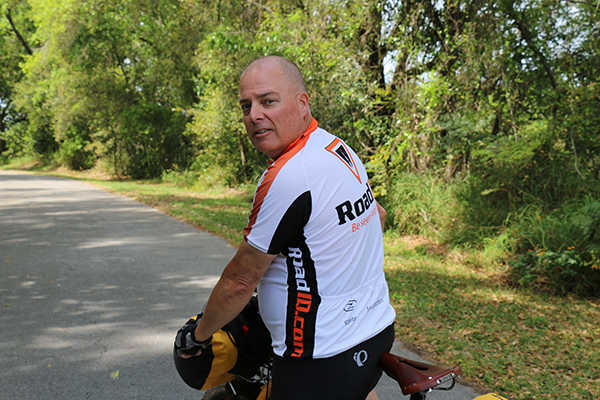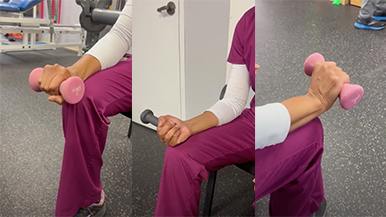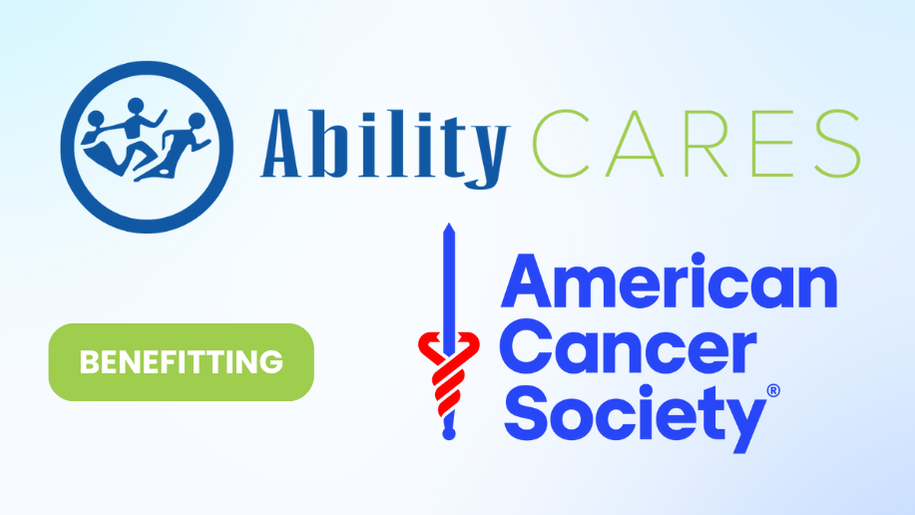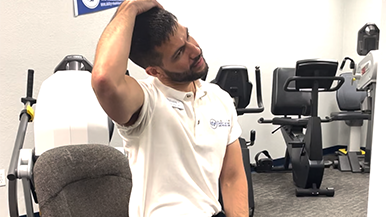Against all odds, Deputy Sheriff Scott Renaux was able to come back from a broken tibia and torn ACL to rejoin his elite helicopter unit at the Orlando police department. He credits his comeback from knee and ankle rehabilitation primarily to the therapists and staff at Ability Rehabilitation.
“Tommy (my therapist) pushed me a little bit, sometimes more than I wanted to,” says Scott. “I’m almost 100% convinced that’s the reason why I was able to get back to 100% and return to full work duty two months ahead of schedule.” Scott was injured while sitting on a motorcycle at a stoplight. He was rear-ended from behind and sustained an ankle injury, a fractured tibia and a ruptured ACL all in the right leg.
“When I saw the doctor, the immediate concern was to heal the tibia and rehab the ankle before they would attempt the (ACL) surgery,” says Scott. “I came to Ability Rehabilitation and worked with Tommy for about a month, getting the stability back in my ankle and allowing the tibia to heal. And following surgery to replace the ACL, I returned here to do rehab for my knee.”
The Impact of Vehicle Accidents on the Knee and Ankle
 It is very common for the ankle to be injured when the foot is pressured or jolted in a vehicle accident. Knee injuries can occur in several different ways, depending on the nature of the crash, such as a side-impact, rear-ender or rollover. The knee can strike the ground or any part of the vehicle resulting in a direct blow to the knee, twisting or hyperextension of the leg.
It is very common for the ankle to be injured when the foot is pressured or jolted in a vehicle accident. Knee injuries can occur in several different ways, depending on the nature of the crash, such as a side-impact, rear-ender or rollover. The knee can strike the ground or any part of the vehicle resulting in a direct blow to the knee, twisting or hyperextension of the leg.

- An anterior cruciate ligament (ACL) tear
- A posterior cruciate ligament (PCL) tear
- Medial collateral ligament (MCL) tear
- Lateral or medial meniscus tear
- Tibial plateau fracture
The anterior cruciate ligament (ACL) is the most often injured knee ligament. It’s particularly susceptible to sudden twisting movements, typically associated with sports like basketball, hockey, and football. The ACL moves across the heart of the knee, connecting the front of the tibia to the back of the thigh bone. The ACL manages rotation and flexion of the knee and stabilizes the shin bone (tibia).
“Scott came to me about two years ago following an auto accident in which he suffered a nondisplaced ankle fracture,” says Tommy, clinic manager and therapist with Ability Rehabilitation at the Clermont, FL location.
“He sought help getting back to work and returning to his passion of cycling. He works with the Orlando police department in a helicopter unit, so he needs to be able to transfer in and out of a vehicle and to perform at a high capacity of function. When Scott first came in with a limp, we knew there were issues that we had to work out with stability and strengthening the lower extremity.”
The Road Back to Recovery
Scott’s rehabilitation journey began with a program to stabilize his ankle and strengthen the muscles around his healing shin bone and lower leg. He developed an instant rapport with Tommy as well as the rest of the Ability Rehabilitation staff.

With his tibia bone and ankle much improved, Scott underwent ACL reconstructive surgery. However, he was still a long way from realizing his dream of returning to work.
“Upon his completion of therapy, we realized that Scott still had continued issues,” says Tommy. “He came back following an ACL reconstruction, and he was just not able to get back to work. He shared a lot of motivation and desire to get back to work, and his passion, which was riding road bikes. Initially, with the ankle, we worked for about eight weeks, and then later on when he came back following the ACL reconstruction, we worked with him for about twelve weeks.”
Rehab Begins Right After Surgery
 Following ACL repair surgery, most patients experience pain and inflammation around the knee. Successful rehabilitation starts right after surgery to allow patients to relieve swelling and discomfort, prevent stiffness and preserve range of motion.
Following ACL repair surgery, most patients experience pain and inflammation around the knee. Successful rehabilitation starts right after surgery to allow patients to relieve swelling and discomfort, prevent stiffness and preserve range of motion.

- Ice and compression wraps
- Leg elevation
- Ankle pumps
- Electrical stimulation
- Refraining from weight-bearing and overloading the knee
Once the pain and swelling have diminished (usually after the first week following surgery), patients can then focus on the next phase of the ACL rehab process: restoring full extension of the knee.
With Tommy and the Ability staff in his corner, Scott fought through adversity, pain and fear, and came out successfully on the other side.
“From the day I came here and began working with Tommy, the girls at the desk, and even some of the other patients that were rehabbing, we all talked to each other,” says Scott. “It was almost like a family experience. It was very warm and inviting. It was not sterile and clinical at all. Everyone was very polite and professional, but I felt very comfortable coming here.”
“And it didn’t bother me to work up a sweat and have fun at the same time. To me, that helped the healing process. Another benefit of having gone through rehab and getting back to 100% is being able to return to a full, active lifestyle, including running, and bicycling, which are my lifelong passions.”
ACL surgery recovery is a slow and steady process that can last anywhere from six months to a year. A successful ACL rehabilitation program stems from the determination and will of the patient, and the experience and proper support of their physical therapy team.



